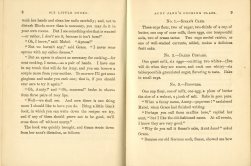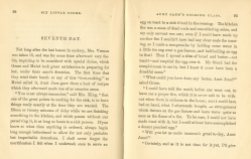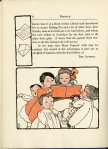About two weeks ago, I was hunting through the catalog to see if we had a copy of a book up for sale. To my surprise, I turned up not only one copy of The Mary Frances Cook Book or Adventures Among the Kitchen People from 1912, but two. Even more surprising was the discovery that our two copies, printed the same year and with same text, had completely different covers and only one included a frontis piece!
The first two images above are the different covers, the first done by Jane Allen Boyer and the other by Margaret G. Hays. The third image is frontis piece that only appears in copy 2. Jane Eayre Fryer’s book is a combination cookbook/storybook (more on that later) that tells the tale of Mary Frances learning to cook and bake from a book created for her by her mother, all with a little help from the pots, pans, and tools in the kitchen.
There are lots of great pictures in this book, but the post today will be a little less about the content (I’ll let the images speak for themselves) and more about using publication to show the challenges and surprises of working with diverse food history collection. I guess, in part, I’m taking an opportunity for me, archivist/blogger Kira, to share some of the small reasons I’m passionate about Special Collections and the History of Food & Drink Collection in particular. I hope you’ll forgive my self-indulgence and read on…
“You never know what you’re going to get”
When a new book or collection arrives, despite conversations with donors and booksellers, something it likely going to catch you off guard. After 3 1/2 years, I’m always making new discoveries–finding two copies of The Mary Frances Cook Book is a wonderful example. And those discoveries almost always lead to a little research. When I took the two copies from the shelf and noticed the different covers, but the same publication date, I was intrigued. I like a good Scooby-Doo style archives mystery. A little WorldCat searching revealed at least three different cover titles: “Mary Frances’ First Cook Book, Adventures Among the Kitchen People,” “The Mary Frances Cook Book, Adventures Among the Kitchen People,” and “Easy Steps in Cooking for Big and Little Girls, or Adventures among the Kitchen People.” This last apparently has a different title on the title page, too: Easy Steps in Cooking; or, Mary Frances Among the Kitchen People. At this point, I don’t have a solid answer, but I suspect all the variation lies in the fact that the book was privately printed in at least three locations. The involvement of two illustrators, too, could account for different cover art. And since I can’t let a mystery alone, I’ll post an update when I have one!
A wealth of hidden connections
The Mary Frances Cook Book or Adventures Among the Kitchen People includes contributions from two illustrators. The page decorations and small images were done by Jane Allen Boyer, as was the cover from copy 2 above. The full pages illustrations and the cover image from copy 1 above were completed by Margaret G. Hays. For our long-time followers, this name might sound familiar. Margaret G. Hays was the author of the 1911 Vegetable Verselets, a book featured on the blog last spring that even inspired a musical event here on campus! Vegetable Verselets was illustrated by Grace Wiederseim, Hays’ sister. (Wiederseim’s influence on her sister’s illustrations a year later is easy to see.) Wiederseim, later Grace Drayton, was the creator of the Campbell Kids. Just a little food art trivia that makes the world a little bit smaller!
On the one hand, many of the publications and manuscripts here in Special Collections are related. That’s part of the reason we collect them. Helping a researcher find papers relating to a family member four generations previous or reminding someone of their mother’s kitchen growing up because we have the same cookbook on display seem like little things that happen in the line of duty. On the other hand, I find satisfaction in the resolution of other people’s mysteries, alongside those I come across in my work processing collections.
Crossing formats, genres, and collecting areas
In many ways, this relates to my point above about making connections. The Mary Frances Cook Book or Adventures Among the Kitchen People is a cookbook. It’s meant to be a first cookbook for young girls. In addition, it’s a storybook. There is a clear educational narrative connecting the recipes as Mary Frances learns about the kitchen. In addition to both of these things, we might even consider this a household manual. Mary Frances is playing the substitute mother role, at least as it relates to the kitchen. Over the course of her adventures, she learns not only how to cook and bake, but how having that role in the home relates to other (future) domestic roles. This publication doesn’t fit only into the Ann Hertzler Children’s Cookbook and Nutrition Literature Collection. It relates to topics in the larger History of Food & Drink Collection, as well.
Although we are limited in the areas we are actively collecting materials here in Special Collections, the overlapping and interweaving of seemingly disparate fields of knowledge is forever revealing itself. Earlier this year, we acquired the letter of a Civil War soldier, written to his wife from a parole camp. Of the eight pages, most of it is consumed by the soldier’s descriptions of the limited (and sometimes barely edible) food he ate during his time as a POW. If he wrote to his wife at all during his imprisonment, his letters would have been heavily censored. Yet, among his first opportunities to write her unrestricted, his focus is food–perhaps a reminder of just how essential it is in our lives. (And yes, I plan to feature the letter on the blog as soon as I can get it processed.)
Sometimes the connections are obvious–Robert Taylor Preston’s correspondence, while usually considered part of our local history materials, relates also to the Civil War and the founding of Virginia Agricultural & Mechanical College and the university’s history. At other times, it may not be quite as clear–it isn’t until you look inside the 1960s cooperative extension publication on kitchen cabinetry that you might connect it to the International Archives of Women in Architecture, when you realize it was authored by a woman.
My point to all this is that materials here never fit into a single category or collecting area, which I find to be an amazing observation. It means answering a reference question or putting together a display is never straight-forward. The more we think outside the box, the more creative an answer we can provide or exhibit we can share with all of you.
I’ve created a much larger post than I expected and it in the higgledy-piggledy of last week, it’s been a bit delayed, but I should be back on schedule this week. (“Higgledy-piggledy,” one of my favorite 19th and early 20th century expressions, actually appears in our feature book, by the way!) I hope, once again, you’ll forgive my diversion. More importantly, as the one year anniversary of “What’s Cookin’ @ Special Collections?!” approaches (how time flies), I hope a post like this gives you a little insight into why I’m here, why the blog is here, and just why I love this project and my job.
Thanks for reading.
















































































